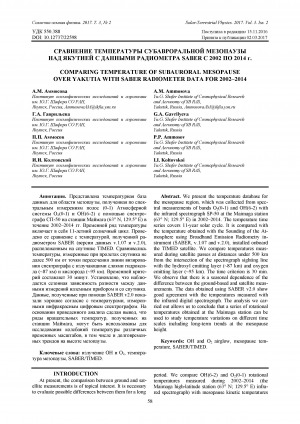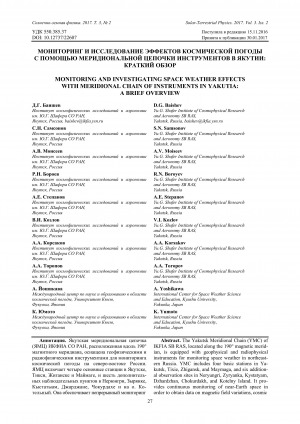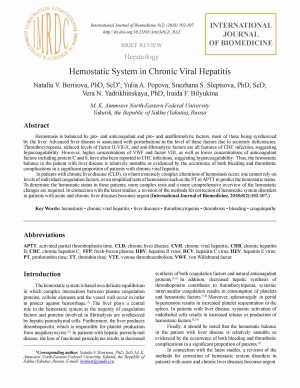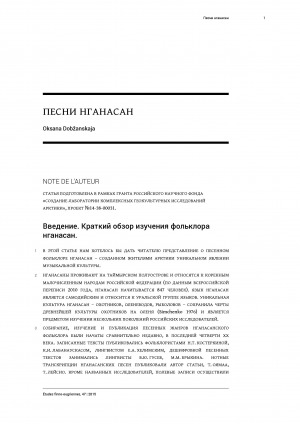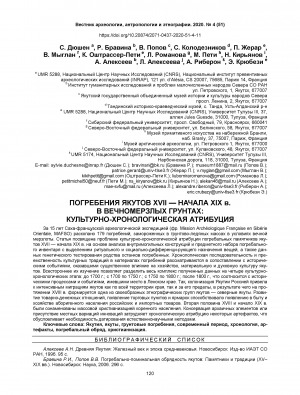Количество страниц: 6 с.
Comparing temperature of subauroral mesopause over Yakutia with SABER radiometer data for 2002–2014 = Сравнение температуры субавроральной мезопаузы над Якутией с данными радиометра SABER с 2002 по 2014 г. / A. M. Ammosova, G. A. Gavrilyeva, P. P. Ammosov, I. I. Koltovskoi // Солнечно-земная физика = Solar-Terrestrial Physics. – 2017. – Т. 3, N 2 : 13-я российско-китайская конференция по космической погоде. – С. 58-63. – DOI: 10.12737/22598.
DOI: 10.12737/22598
Количество страниц: 24 с.
На основе остатков ископаемых организмов, включая макрофоссилии растений, древесный уголь, пыльцу и беспозвоночных, сохранившихся в сингенетических отложениях Батагайской мерзлотной толщи Сибирско-Янского нагорья, мы реконструировали историю окружающей среды в течение морских изотопных стадий (MIS) 6-2. Две ископаемые коллекции, исключительно богатые растительными остатками, позволили детально описать палеорастительность во время двух климатических экстремумов позднего плейстоцена - наступления последнего ледникового максимума (LGM) и последнего межледниковья. Кроме того, всего 41 коллекция была использована для описания истории растительности с предпоследнего холодного этапа MIS 6. Соответственно, луговые степи, аналогичные современным сообществам фитосоциологического порядка Festucetalia lenensis, формировали основную растительность во время саальского и вейхзельского холодных этапов. Холодостойкие тундрово-степные сообщества (Caricirupestris-Kobresietea bellardii) в том виде, в котором они встречаются сегодня выше линии леса, в отличие от более северных районов, в основном отсутствовали. Во время последнего межледниковья основной растительностью на участке были открытые хвойные леса, похожие на современную лиственничную тайгу. Обилие древесного угля указывает на лесные пожары во время последнего межледниковья. Следовательно, луговые степи существовали на Янской возвышенности на протяжении всего исследуемого периода от МИС 6 до МИС 2, что свидетельствует об удивительной экологической стабильности. Таким образом, доля луговой степной растительности просто менялась в зависимости от преобладающих климатических условий. Их сохранение свидетельствует о низком количестве осадков и относительно теплом вегетационном периоде на протяжении всего позднего плейстоцена и после него. Изученная ископаемая летопись также доказывает, что современные степи на Янской возвышенности возникли не позднее голоцена, а являются реликтами ранее непрерывного степного пояса, простиравшегося в плейстоцене от Центральной Сибири до Северо-Восточной Якутии. Сохранение растений и беспозвоночных, характерных для растительности луговых степей во внутренней Якутии на протяжении позднего четвертичного периода, указывает на климатическую непрерывность и подтверждает пригодность этого региона в качестве арефугиума и для других организмов плейстоценовой мамонтовой степи, включая знаковых крупных травоядных
Woodlands and steppes: Pleistocene vegetation in Yakutia's most continental part recorded in the Batagay permafrost sequence / K. Ashastina, S. Kuzmina, N. Rudaya [etc.] // Quaternary International. - 2018. - Volume 196. - P. 38-61. URL: https://www.sciencedirect.com/science/article/abs/pii/S0277379118300672?via%3Dihub (дата обращения: 29.10.2024). - References: p. 58-61 (117 titles).
DOI: 10.1016/j.quascirev.2018.07.032
Количество страниц: 9 с.
- Математика. Естественные науки > Астрономия. Астрофизика. Исследование космического пространства. Геодезия,
- Математика. Естественные науки > Геология. Геологические и геофизические науки,
- НАУКА ЯКУТИИ > МАТЕМАТИКА. ЕСТЕСТВЕННЫЕ НАУКИ > Астрономия. Астрофизика. Исследование космического пространства. Геодезия,
- НАУКА ЯКУТИИ > МАТЕМАТИКА. ЕСТЕСТВЕННЫЕ НАУКИ > Геология. Геологические и геофизические науки.
Monitoring and investigating space weather effects with meridional chain of instruments in Yakutia: a brief overview = Мониторинг и исследование эффектов космической погоды с помощью меридиональной цепочки инструментов в Якутии: краткий обзор / D. G. Baihsev, S. N. Samsonov, A. V. Moiseev, R. N. Boroyev, A. E. Stepanov, V. I. Kozlov, A. A. Korsakov, A. A. Toropov, A. Yoshikawa, K. Yumoto // Солнечно-земная физика = Solar-Terrestrial Physics. – 2017, т. 3, N 2 : 13-я российско-китайская конференция по космической погоде. – С. 27-35.
DOI: 10.12737/22607
Количество страниц: 6 с.
Гепатоцеллюлярная карцинома является одной из наиболее распространенных злокачественных опухолей, характеризующаяся неблагоприятным жизненным прогнозом при отсутствии своевременного и адекватного лечения. Таким образом, ранняя диагностика гепатоцеллюлярной карциномы имеет решающее значение для улучшения качества и увеличения продолжительности жизни. Измерение концентрации Ot-фетопротеина и ультразвуковое исследование печени используются для ранней диагностики рака печени. Однако, чувствительность и специфичность измерения О-фетопротеина в скрининге рака печени не всегда являются удовлетворительными. Достижения биохимии, молекулярной генетики и системной биологии в интегративном анализе опухолей и их окружения привели к идентификации новых молекулярных маркеров гепатоцеллюлярной карциномы, которые могут быть перспективными инструментами для улучшения имеющихся алгоритмов диагностики и лечения гепатоцеллюлярной карциномы.
Hemostatic system in chronic viral hepatitis / Natalia V. Borisova, Yulia A. Popova, Snezhana S. Sleptsova [и др.] ; M. K. Ammosov North-Eastern Federal University // International journal of biomedicine. - 2018. - Т. 8, N 2. - C. 102-107. - DOI: 10.21103/Article8(2)_RA2
DOI: 10.21103/Article8(2)_RA2
Количество страниц: 13 с.
- Религия. Теология,
- Общественные науки. Образование > Этнография. Обычаи. Жизнь народа. Нравы,
- Искусство. Фотография. Музыка. Игры. Спорт > Музыка,
- НАУКА ЯКУТИИ > РЕЛИГИЯ. ТЕОЛОГИЯ,
- НАУКА ЯКУТИИ > ОБЩЕСТВЕННЫЕ НАУКИ > Этнография. Обычаи. Жизнь народа. Нравы,
- НАУКА ЯКУТИИ > ИСКУССТВО. ФОТОГРАФИЯ. МУЗЫКА. ИГРЫ. СПОРТ > Музыка.
Dobzhanskaya, O. E. Samoyedic shamanic drums: some symbolic interpretations / Oksana Dobzanskaya // Shamanhood and Mythology Archaic Techniques of Ecstasy and Current Techniques of Research : Honour of Mihály Hoppál, celebrating his 75th Birthday / edited by Attila Mátéffy, György Szabados, Tamás Csernyei. - Budapest : Robinco, 2017. - 512 p. - P. 63-75.
Количество страниц: 15 с.
Dobzhanskaya, O/ E. The Living Has Sound. The Dead Is Silent / Oksana E. Dobzhanskaya ; Moscow State University // Anthropology & archeology of Eurasia. - 2016, Т. 55, N 1. - С. 7-21. - DOI: http://dx.doi.org/10.1080/10611959.2016.1263485
DOI: http://dx.doi.org/10.1080/10611959.2016.1263485
Количество страниц: 20 с.
Dobzhanskaya, O. E. Песни нганасан / Oksana Dobžanskaja // Études finno-ougriennes. - 2015, N. 47. - P. 1-20.
Количество страниц: 13 с.
Dobzhanskaya, O. E. The opposition of the Nganasans ritual and non-ritual folklore music styles as a reflection ofthe ideas of the spatial organisation / Oksana Dobzanskaya ; Arctic State Institute of Culture and Arts // The Arctic in a space of knowledge :The collection of Saint Petersburg State University scientific events articles (2020–2021) / Saint Petersburg State University ; редактор: Nadezhda Kharlampieva. - Saint Petersburg : Saint Petersburg University Press, 2022. - P. 142-154
Источник: SHS Web of Conferences. - 2022, Т. 134.
Количество страниц: 7 с.
Целью данного исследования является изучение звукоиздающих подвесок на шаманском костюме эвенков, якутов и нганасан в единстве шаманского ритуального комплекса и ритуальных музыкальных традиций. Шаманские подвески интерпретируются как особый текст культуры, отражение геокультурных представлений народов Арктики. Статья основана на материалах полевых исследований, проведённых авторами на Таймыре в 1989–1990 годах, в Оленёкском эвенкийском национальном округе Якутии в 2014 году, а также на научных публикациях. Звуковой мир шаманского ритуала — это сложная звуковая картина, которая формируется при использовании вокальных, вербальных, вокально-речевых, сигнальных, инструментальных типов интонации. Движения шамана сопровождаются звуком сталкивающихся подвесок на костюме шамана и его составляющих (повязке, обуви, перчатках).
Звукоиздающие подвески были описаны этнографами и музыковедами, но не рассматривались в связи с геокультурными исследованиями. Металлические подвески на костюме шамана обозначают священные пространственные модели Вселенной (образы небесных тел — солнца, луны, звёзд), мифологические пространства Верхнего, Среднего и Нижнего миров, населённые духами-помощниками шамана — птицами, животными, антропоморфными существами, символизируют части человеческого тела и т. д. Перспективы изучения подвесок на костюме шамана как символического воплощения ландшафта заключаются в более полном описании и обобщении всех известных материалов, включая анализ костюмов шаманов из этнографических музейных коллекций.
Reflection of Arctic geocultures in the sounding attributes of the shaman costumes of Sakha, Evenks and Nganasans / Oksana Dobzanskaya, Vera Nikiforova, Varvara Dyakonova ; Arctic State Institute of Culture and Arts // SHS Web of Conferences. - 2022, Т. 134. - С. 1-7
Количество страниц: 12 с.
- Общественные науки. Образование > Этнография. Обычаи. Жизнь народа. Нравы,
- Краеведение. Археология. География. Биографии. История > Историческая наука. Историография > Археология,
- НАУКА ЯКУТИИ > ОБЩЕСТВЕННЫЕ НАУКИ > Этнография. Обычаи. Жизнь народа. Нравы,
- НАУКА ЯКУТИИ > КРАЕВЕДЕНИЕ. ГЕОГРАФИЯ. БИОГРАФИИ. ИСТОРИЯ > Историческая наука. Историография > Археология.
Frozen graves of Yakutia, a chronological sequence / S. Duchesne, R. Bravina, V. Popov [и др.] // Вестник археологии, антропологии и этнографии. – 2020. – N 4 (51). – С. 120-130. — DOI: 10.20874/2071-0437-2020-51-4-11.
DOI: 10.20874/2071-0437-2020-51-4-11
